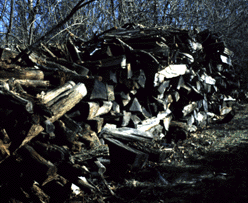
Wacky Stack
Margaret Yuko Kimura

In the past six years, the themes,"stacking" and "layering"
have been important in my art making. As a printmaker, I have been particularly
interested in accumulating layers of colors through which to capture subtle
changes of colors. I also have been working on three dimensional forms by
using the same idea of "layering."
.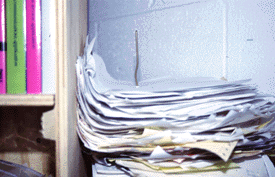
I have been looking for things that have been and continue to be accumulated
in our daily life, on the streets, at friend's houses,in art studios and
in other places. There are layers and layers of creative or not so creative
materials. People pile up many things in life. They have different styles
with their own purposes. It is fascinating for me to observe this ordinary
human behavior. The layers of papers have been my particular interest.
At my parent' house in Tokyo, Japan, they make stacks of stuff everywhere.
They save empty boxes, plastic containers, papers and almost everything,
including small junky old toys which I used to play with. Now it is difficult
to find a space to put their bodies.
Some people feel guilty about throwing away materials, finding that they
are still useable. If you visit Japan, you may find that people traditionally
put things in containers or wrap them with nice papers. So those materials
may end up accumulated in the corner of your room.
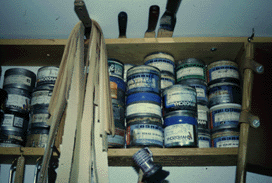

Recently, I visited one of my printmaking professor's house to view the
various piles. They have an amazing amount of materials that are stacked.
It was interesting to look at the details, how they build all the little
things together to create an effect in which you can find a repeated pattern
of colors and textures. In this artist's studio, there are piles of papers,
prints, tools, inks, rolls of felts and newsprints and so on. Even small
bits and pieces are often put together in a form of stack.

The experience of piling stuff is a daily activity in order to organize
our living space. Sometimes ordinary layers look unusual. Messy piles are
perhaps made with rapid changes and the business of the stack creator, because
people do not have enough time. This kind of pile suggests the phenomenon
of chaos. Some stacks appear as if they are about to fall. The chaos presents
the constant changes of our life.
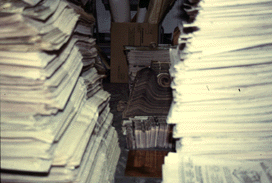
For the last couple of months, I have been stacking a great number of
American and Japanese newspapers in my studio. I don't think I am an intense
newspaper reader, rather a newspaper user. Newspaper is a daily material
from which people receive current information about the world. After reading,
the papers are usually thrown away immediately. My experience with newspaper,
however has been to see it as a material to create art work. Initially,
I look through newspapers like other people do for information. When I see
an article that I am particularly interested in, I clip it out. Then, afterwards,
I fold the newspapers neatly and stack them one after another in different
structures in my studio. As these layers grow, I find it fascinating to
look the edges. They visually remind me of the strata of the mountainside
or of Indian temples. The accumulation of paper manifest tension and gravity.
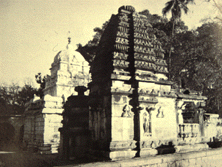
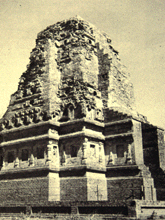
During this semester, I have been studying history of ancient Indian art. Some of the Indian temples have layers of segments. They have distinct visual layers. Each layer took a couple of decades and gives a record of the history of time that took to create it. Material and time are stacked in this monument.
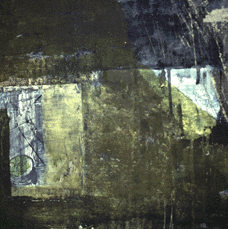
As a graduate student in printmaking, I have been interested in layering several media for my work, Intaglio, drawing, painting, and even metal plates which were used for printmaking. At the same time,I often incorporate references from art history. In this way, my work has a multi-layerd structure and content.
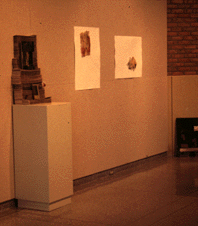

Last month, my colleague, Masha Ryskin and I had a exhibition at the Media
Union Gallery. Since both of our works have a fragmented quality, this show
was titled "Bits and Pieces". This presentation was the first
time for me to combine stacks of newspapers and printmaking pieces together.
All the newspapers were chopped into three to four segments with a manual
paper cutter in order to show the sharp edges of papers and then layered
neatly on top of one another and tied each segment with string for a each
segment. They were built to a height of about two feet. The layers were
gradually getting smaller towards the top. Then,the fragmented printmaking
plates,prints on homosote and layers of drawings were placed on the skinny
platforms. Although,most of my works were displayed on white pedestals,
my initial plan was to build the whole base with newspapers. I do not have
newspapers subscriptions,so I asked other people to collect newspapers.
But I still could not accumulate enough. When I was making newspaper pedestals,
Giacometti was my inspiration, because he treated pedestals as an important
part of his work.
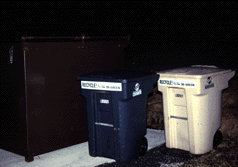
Recently, I have become aggressive, running around and hunting for newspapers.
I have gone to a recycling center to get a mountain of old newspapers and
I look through recycle bins every morning in front of my apartment complex
and around the north campus area. I found that the wrinkled edges of old
dirty papers incorporate the gestures of human touch.
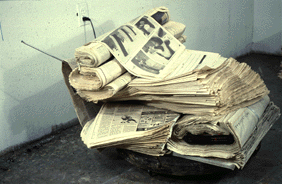
The first project, using newspapers, was called "Temporary Chair"which
I made last year. A sheet of paper is fragile, yet a layer of paper becomes
strong and solid. This project was about the accumulation of information.
In addition, I wanted to bring into question the temporary life of newspaper
as a thrown away material. Today we can receive a great amount of information
through television networks and Internet on computer, but I personally hope
that newspaper will survive forever.

So, in my work, the importance of stacking and referring to the process
of layering has been a constant theme. I think this is simply because I
can find these human activities of accumulating stuff everywhere in daily
life.
April, 1997